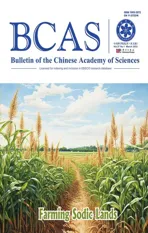Protein Entry Path into Chloroplasts Unraveled
2023-09-09ByYANFushengStaffReporter
By YAN Fusheng (Staff Reporter)
A team of scientists led by Dr.LIU Zhenfeng at the CAS Institute of Biophysics (IBP) made a breakthrough in understanding how chloroplasts– the cellular powerhouses responsible for converting sunlight into energy – import proteins from the cytosol.
The study, published online in the journalNatureon January 26, examined how the TOC-TIC supercomplex,a channel-like structure that spans the outer and inner envelope membranes of chloroplasts, ferries proteins from cytosol into chloroplast.
Using cryo-electron microscopy, the researchers revealed the detailed architecture of the TOC-TIC supercomplex from an alga and identified thirteen different protein subunits within it.A unique membrane protein called Tic214 was found to act as a bridge,connecting the outer and inner membrane complexes.
The study also unveiled a hybrid barrel-shaped channel formed by Toc90 and Toc75 in the outer membrane and a funnel-like channel stabilized by lipid molecules at the interface between Tic214 and Tic20 in the inner membrane.These channels may facilitate the import of proteins into chloroplasts.
Using molecular dynamics simulations, the researchers analyzed the pores inside the TOC and TIC channels and predicted the interactions between the transit peptide and the TIC complex.This information could help explain how different preproteins –protein precursors that required further processing to become functional – are translocated through the TOC-TIC supercomplex to various chloroplast compartments,ultimately contributing to a deeper understanding of photosynthesis and chloroplast function.

The TOC-TIC translocon supercomplex imports the preprotein, a type of protein that is synthesized as a precursor molecule and undergoes further processing to become functional, from cytosol into chloroplast.(Image by Dr.LIU Zhenfeng’s group)
“This and another such structure reported inCellby Jinet al.are the first high-resolution structures of the TOC and TIC complexes —they provide surprises and insights, but also raise many questions,”commented two researchers from the Kyoto Sangyo University in the same issue ofNature.
Still, more challenges lay ahead to elucidate the precise functions of each component and how they orchestrate to perform a proper function of protein translocation and to sort them into distinct chloroplast compartments, say the authors.
